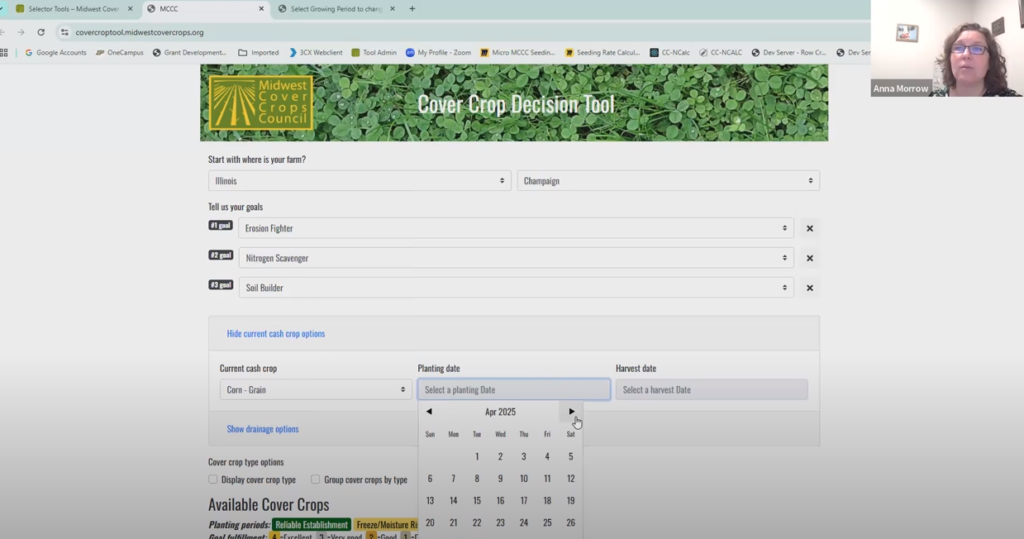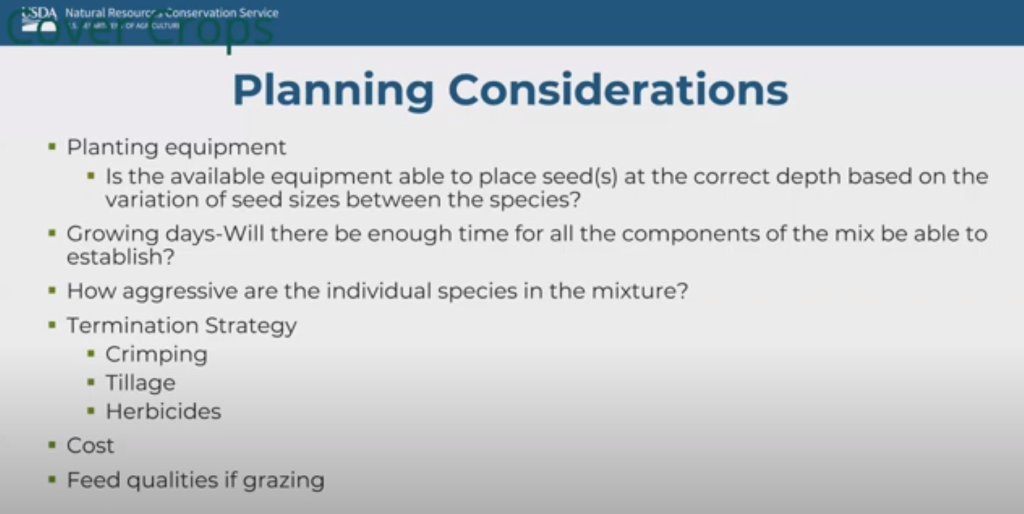On the Illinois Cover Crop On-Farm Network’s (ICCON) March call, ICCON was joined by Anna Morrow of the Midwest Cover Crops Council (MCCC) and Brett Roberts, IL State Agronomist with Natural Resources Conservation Service (NRCS). The pair discussed the collaboration between the MCCC and NRCS and how that work has led to cover crop species and rate recommendations for farmers based on their location. Anna kicked off the call and provided an overview of the MCCC row crop selector tool.
The row crop selector tool is state based – meaning that the recommendations provided through the tool are tailored to NRCS recommendations and requirements for each state. The tool is web based and easy to use. All that is needed to get started is the simple input of your state and county. This allows the tool to geographically access the 30-year climate history for your area to provide the correct planting dates by species for your given latitude/plant hardiness zone. Producers and advisors can identify and select goals they would like to set for their cover crop species options. Goals such as erosion fighter, soil builder, weed fighter, and nitrogen fixer are all available. Anna described how these filters can help producers narrow down the selection of species. The tool assigns a grade to each species using a 1-4 rating with 4 being the best fit for your chosen goals. The species which best fit the selected criteria are automatically filtered to the top of the list to simplify the process. Date ranges are laid out in a linear diagram and users can also input their expected planting and harvest dates. That range is shadowed out to easily see how cover crop planting dates line up with expected cash crop dates – this can be especially helpful for species selection but also for deciding which cover crop seeding techniques may fit best for you. The tool also allows users to input information about the drainage properties of their given soil and whether or not tile drainage is present. This can open up the species options significantly because most species will not perform well in poorly drained environments.

Anna walked the group through the features of the Midwest Cover Crop Council’s Cover Crop Decision Tool.
Once a user has interest in a species, additional details are available when users select the name. From there, information about seeding rates, termination, potential advantages and disadvantages, etc. can be found to help make decisions about what species will work best.
Following Anna’s walk through of the tool, Brett Roberts walked the group through the NRCS approach to cover crop mixes and why a farmer would want to consider planting more than one species of cover crop. Primarily, Brett emphasized that two or more species from different plant functional groups can often better address the goals of the farmer than a single species can alone. Brett mentioned that multiple species also provide added above and below ground diversity, especially in a two crop rotation. Multiple species also provide some level of control over the C:N ratio of the cover crop biomass and can hedge against the risk if one particular species does not establish or perform well in a given year.
Brett advised that new and beginning cover crop farmers are not recommended to jump right into complex mixes. Instead, Brett encouraged to start small and use a single species or just two until they have gained some experience. When putting together cover crop mixes there are many considerations that need to be taken into account – these become more apparent with more experience. Items like planting equipment requirements – knowing that the seeding method to be used will be capable of placing the seeds in the mix at the proper depth for germination. Brett emphasized the importance of understanding the growing degree day (GDD) requirements for the various species to become established. This way, the benefit of having certain species in a mix can be observed. Additionally, understanding the termination timeframes and requirements is also important because not all species will have the same response. Though there are other considerations as well, the take home message is that the benefits of mixes can be substantial when managed properly.

Though there are other considerations as well, the take home message is that the benefits of mixes can be substantial when managed properly.
Brett also discussed some of the basic “rule of thumb” math used in helping decide how many pounds of each seed to include in the mix. There is nuance to everything, but the basic math is to keep equal proportions of each species in the mix. If the mix has two species take the low end recommended seeding rate of each and multiply by 0.5 (or divide by 2) to get the PLS recommended seeding rate for each species.
Anna and Brett’s full presentation can be viewed on ISAP’s YouTube channel. ICCON will meet in-person on Thursday, April 3rd for the Farm Farm to Filtration: A Tour of Conservation in Action field day. Register today and join the network in-person! If you are interested in joining the Illinois Cover Crop On-Farm Network to learn about new research and hear from cover crop specialists across the Midwest, please join our google group by sending an email to hello@ilsustainableag.org.